#offensive warfare
Explore tagged Tumblr posts
Text

Why would a battle fought 54 years ago provide key insight on what Hamas' strategy is today?
Asymmetric Warfare. It's a term that most people don't really understand. Before I did this, I was a United States Army Green Beret and I did a couple of combat tours in Iraq. And needless to say, asymmetric warfare was kind of our thing.
So, in practical terms, it is a type of war between belligerents whose relative military power, strategy or tactics differ significantly. And as a result of this, the weaker opponent will use unconventional tactics in order to maximize one's strengths against a stronger opponent's weaknesses or vulnerabilities.
For instance, an Insurgent force does not have the freedom of movement or firepower necessary to attack a forward operating base or a heavily armed column. So instead, they focus on softer logistical targets. They may choose to use a remotely activated roadside bomb instead of engaging in direct fire.
In many situations, the weaker adversary has fewer personnel and resources. And so, a significant part of their strategy is to preserve those limited resources and use the munitions that they have to the greatest possible advantage.
But here's the thing. To pull this off long term, you generally need a consistent means of supply combined with enough territory to hit, run and then hide. And Hamas doesn't have these things, at least not in sufficient supply to win against the IDF.
So, what's their strategy? What can Hamas leverage that will allow them to conduct offensive operations against a much stronger opponent and then avoid getting destroyed by the IDF's vastly superior military capability?
And the answer to that question as horrific, as it is, is civilian casualties, but probably not the ones you're thinking.
To understand this, let's discuss that example 54 years ago. The Tet Offensive in the Vietnam War virtually wiped out the Viet Kong. It was by every objective measure, a complete tactical failure. But strategically, it was invaluable. Because while achieving none of its military objectives, the Tet Offensive shattered Americans' perspective on the situation on the ground.
Opponents of the war were able to effectively use the offensive as a demonstration of the futility of American involvement. Hollywood, Academia and many in the mainstream media went to work convincing the American people that the war couldn't be won. Or perhaps just shouldn't even be fought. And in a representative government, when the electorate decides that a war is lost, it is, regardless of the situation on the ground.
Now, understand something. I'm not making an argument for the pros or cons of fighting the Vietnam War. I'm merely illustrating a point about modern Asymmetric Warfare. The lesson of the Tet Offensive is when fighting the West, you don't defeat their military. You win their electorate. And the way to do that is through the institutions which shape culture in the West, namely Hollywood, the Media and Academia.
If Hamas had decided to engage in a conventional military attack directed at only legitimate military targets, the IDF would have effectively destroyed their war fighting capability within days, and Hamas knows it. So, they engaged in asymmetric strategy.
Once we understand this, their actions on October 7th, as horrific as they are, begin to make more sense. Hamas didn't just target civilians because they were easy targets or because they despise Jews, although both of those things are true. The attack and the subsequent taking of hostages was actually designed to elicit a major response from the IDF.
But why? Well, maybe it's because to achieve their strategic objectives, Hamas needs civilian casualties. And more specifically they need Palestinian civilian casualties. And this is why.
The two entities in this conflict that lose the most from a greater peace agreement in the Middle East are Iran and the terrorist organizations they support. Upsetting this process requires much more than the random launching of rockets into Israel or strikes against legitimate military targets. The IDF is more than capable of handling such incursions, and the Israeli people have become all too accustomed to weathering such attacks without demanding an overwhelming military response. something more significant was required.
And October 7th created the kind of conditions that demanded a significant and sustained response. They needed something so obscene that Israel would have no choice but to hit back hard.
And this is where the second component of Hamas' strategy plays out. How to get Palestinian casualties. Any government actually worried about civilian casualties dedicates resources to evacuating their own civilians from hostile areas and attempts to separate the civilian population from legitimate military targets. So what conclusion should we come to when a governing body decides to do the exact opposite?
In this asymmetric environment, Hamas is not only incentivized to kill Israeli civilians, they're incentivized to maximize their own civilian casualties in the short run in order to elicit Western intervention on their behalf. As easy as it might be to explain Hamas's strategy away as nothing but mindless bloodlust, it is actually more sinister than that.
Hamas is responding to the incentive structures certain elements within the West have created. Hamas understand that the real Battlefield is not in Gaza but in the streets, University halls and newsrooms of the West. And so that is their target. And while a ceasefire seems like a humanitarian response to the tragic death of civilians, leaving Hamas intact as an operational and governing body will ultimately just reinforce that the perverse incentive structure remains the same.
And that while the West may claim to "not negotiate with terrorists," they always seem to force Israel to as soon as it becomes politically inconvenient for them.
So here's the hard reality. If you actually want to achieve anything resembling a lasting peace in this part of the world, you're never going to achieve it by creating conditions where terrorists are incentivized to hurt both the civilians of their enemies, and their own in order to achieve their political objectives.
==
This, of course, was completely obvious from the moment of the al-Ahli Hospital hoax, where Western outlets worked overtime to spread Hamas propaganda without regard for truth, all the way through to the present-day "protests" which are anything but organic or grass-roots.
#Nick Freitas#asymmetrical warfare#propaganda#hamas propaganda#hamas#hamas terorrism#IDF#Israel#israel defence forces#oct 7#october 7#october 7 massacre#terrorist attack#Tet Offensive#Vietnam War#religion is a mental illness
35 notes
·
View notes
Text

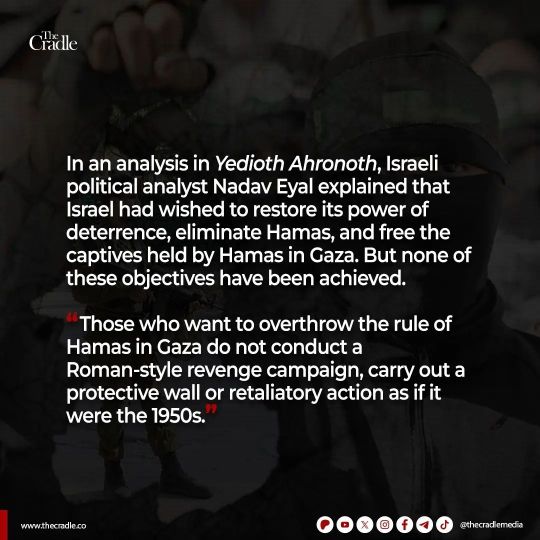
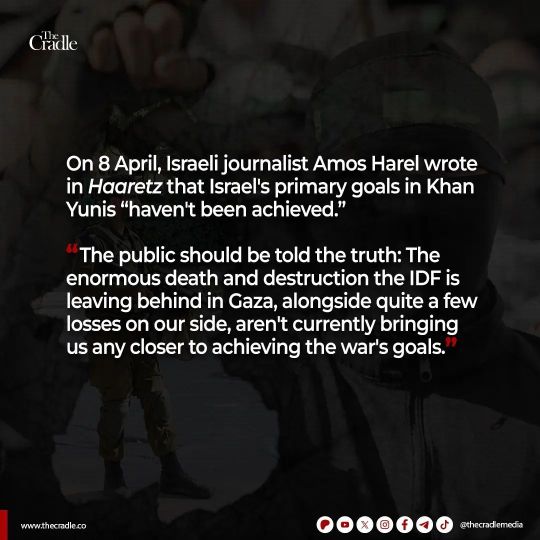



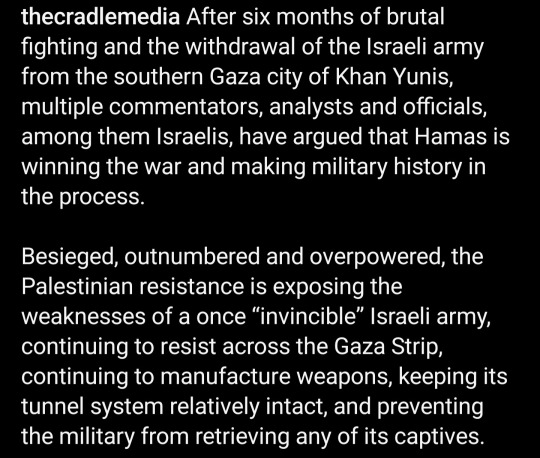

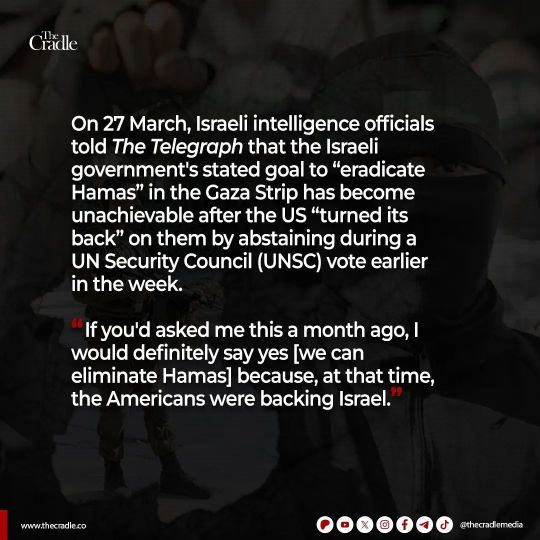
I'm not sure why some people are surprised by this. It's an entirely different method and mindset of fighting when you have nothing left to lose and believe down deep in what you are doing. Compare that to untrained 19-20 year old idiot conscripts who would rather be on TikTok and have zero discipline and this is the result.
#israeli revenge campaign#inept iof conscripts#hamas#military history#khan younis#al shifa hospital#martyrdom#palestinian resistance#apartheid#save palestine#ethnic cleansing#israel is an apartheid state#seek truth#free palestine 🇵🇸#genocide#illegal occupation#israel is committing genocide#israeli war crimes#israel lies while palestine dies#all eyes on rafah#rafah#ground offensive#al qassam brigades#qassam brigades#guerrilla warfare#un security council#as usual israel is taking zero responsibility and blaming the ONE TIME the US abstained on a UN vote as to why they are losing to Hamas#do they honestly people believe that utter nonsense?#the IOF are poorly trained with nearly 20 percent of their deaths a result of friendly fire cuz they act like theyre in a video game!#propaganda kills
22 notes
·
View notes
Text
concerning Simon “Ghost” Riley’s overall aesthetic…
#admin#simon “ghost” riley#opinion#poll#call of duty#modern warfare ii#aesthetic#referring to ‘22 Ghost no offense ‘09#goth#emo#punk
22 notes
·
View notes
Text
I love how much of the Western Media is insistent on comparing Hamas to the Vietnamese National Liberation Front
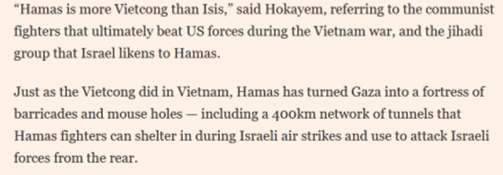





Like I kinda get where they're coming from but it's still so funny to all these commentators basically just going "huh these Guerillas that use subterranean tunnels are giving me real Viet Cong vibes"
#stella speaks#the articles I grabbed these from in order are#https://www.ft.com/content/913d366e-0ace-4463-a004-d293aa49c673#https://mwi.westpoint.edu/underground-nightmare-hamas-tunnels-and-the-wicked-problem-facing-the-idf/#https://foreignpolicy.com/2023/11/01/gaza-hamas-israel-idf-tunnel-warfare-vietnam-viet-cong/#https://www.politico.eu/article/hamas-attack-might-be-israels-tet-offensive/#https://www.bbc.com/news/world-middle-east-28430298#https://canadiandimension.com/articles/view/hamas-campaign-recalls-tet-offensive-could-this-also-be-a-turning-point
20 notes
·
View notes
Text

Shadow Company sanctioned lacrosse game
#call of duty#modern warfare#blender renders#call of duty modern warfare#phillip graves#philip graves#shadow company#thanks to mikk for suggesting lacrosse#its now burned into my canon#some companies do ultimate frisbee or whatever#nah not shadow#this was supposed to be a quickie render but well#hes my wife what can i say#jackies bf/husband but hes MY wife#its simple#i could be idealist amd say he was captain#but nah he was probably just on offense#(knows nothing about lacrosse apart from whats in teen wolf)#hes too high and mighty for (american) football
82 notes
·
View notes
Link
The article "Hell in the Hedgerows: What U.S. Troops Faced in Normandy" by Tom Laemlein, published on The Armory Life, discusses the intense challenges faced by U.S. troops in the Normandy campaign during World War II. After successfully landing on the Normandy beaches, Allied forces encountered the Bocage country’s dense hedgerows, which had not been anticipated in planning. These natural and man-made escarpments created formidable defensive positions for German soldiers. German forces utilized numerous tactics, including the use of machine guns like the MG 42 and MG 34, mortars, anti-tank weapons such as the Panzerschreck and Panzerfaust, and snipers. U.S. troops had to adapt quickly, employing bulldozer tanks, hedge-cutters, and innovative tank-infantry team tactics to overcome these obstacles. This led to gradual gains that eventually opened the road to Paris, showcasing both the ingenuity and resilience of U.S. forces in their efforts to break through the German defenses.
#Normandy#World War II#Hedgerow warfare#Operation Overlord#D-Day#Allied forces#German forces#Bocage countryside#Armored vehicles#Infantry tactics#Field Marshal Bernard Montgomery#General Omar Bradley#Hedgerow cutters#Sherman tanks#M4A1 tanks#Close-combat fighting#Historical battles#June 1944#Military strategy#Normandy invasion plans#Saint-Lô offensive#Terrain challenges#Military engineering.
5 notes
·
View notes
Text
The Big Boy with the Skull Face
1 hour vs 11 hours
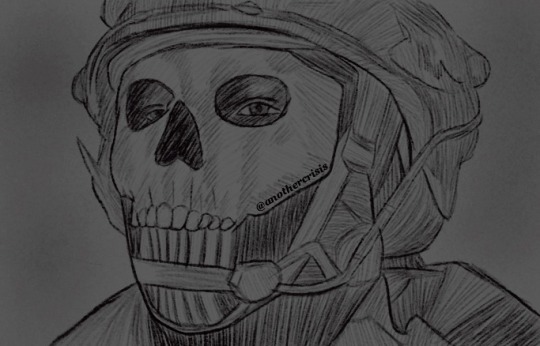
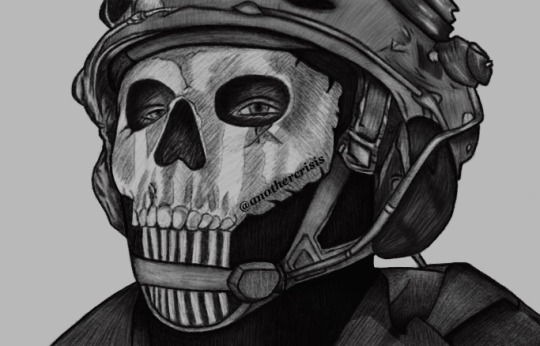
#I finally understand why some artists always seem on the verge of collapse#this took so much out of me#I will be able to give very little for the next 3-5 business days#thanks for your understanding#this is why I’m a writer and not an artist#please appreciate this#that’s my kinnie right there#si no offense but I’m sick of looking at your face#never would’ve thought I’d say that#simon ghost riley#call of duty#modern warfare ii 2022#cod fanart#I did the art thing#it’s the crisis talking
88 notes
·
View notes
Note
Love the little nod to “your captain” where price thinks him a tank have had sex in a shower before, I was like yeh you have in another universe my guy! Oh an him taking her toast? If I was sat at that table I’d be like oh they defo fucking cause unless your doing me good ain’t nobody taking my toast 😂 ❤️
Love when you lot notice the little nods 💖
Haha an that had me howling! Tank is getting it good so Price is getting that toast 😂😂😂
Anon and Soap sat at the table 👀

#captain price#captain john price#john price#price x tank#call of duty#captain john price x reader#captain price x reader#call of duty modern warfare#cod mw#modern warfare#everybody knows#everybody knows that he fucks you#side eye#criminal offensive side eye#bombastic side eye#get that toast girl#they fuckin#price x tank x ghost#captain price smut#ghost smut#cod ocs#cod oc tank
39 notes
·
View notes
Text

we don't talk about Kyle enough
bombastic side eye criminal offensive side eye
#call of duty#cod mwii#cod modern warfare#kyle gaz garrick#kyle garrick#cod mw2#cod#cod gaz#bombastic side eye#criminal offensive side eye
17 notes
·
View notes
Text

German T-Gewehr anti-tank rifle team of Infanterie-Regiment Nr. 124 of 27 Württemberg Infanterie-Division, France, late summer-autumn 1918. Accessioned as Q 44794 in the collections of the Imperial War Museum
#anti-tank rifle#t-gewehr#trench warfare#bray-sur-somme#world war 1#hundred days offensive#end of world war 1#deutsches kaiserreich#imperial germany#deutsches heer
3 notes
·
View notes
Text
SOUTH VIETNAM’S THERMOPYLAE
The Spartan-like defense and tragedy of Xuan Loc, April 1975. After fighting for twelve straight days, the valiant stand at Xuan Loc by heavily outnumbered ARVN soldiers echoes the famed sacrifice of King Leonidas’ 300 Spartans facing Xerxes’ Persian masses at the Battle of Thermopylae in 480 B.C. Greece. The Persians then marched south and captured Athens. Read about the last major battle of…

View On WordPress
#300 Spartans#A Vietnam War Story#books war#cherry soldier#Combat Infantry#digital books#Easter Offensive#firefights#jungle warfare#Vietnam blog pages#Vietnam conflict#war books
2 notes
·
View notes
Text
Ukraine hopes that their push into Russia influences the fate of the war
#asymmetric warfare#buffer zone#counter-offensive#diplomacy#Kursk#Peace#prisoner exchange#Putin#Russian troops#territorial gains#Ukraine#Zelensky
0 notes
Text
Psychological Warfare is Real
The words, “psychological warfare” jumped out at me as I read my morning devotional a few days ago. Not only did I consider them for myself, I sent the devotional to a friend who is smack dab in a mind-battle!In many ways our mind is a battlefield! We often find ourselves dodging fiery darts of doubt, negativity, and pessimism. That’s because our adversary, the devil, is a psychological warfare…

View On WordPress
#battlefield#battlefield of the mind#blog#Christ followers#christian#defense#devotional#divine interceptor#facebook#fiery darts#fruit of the spirit#inspiration#mental missiles#mind battle#not good enough#null and void#offense#psychological warfare#scriptures#tactical warfare
0 notes
Text
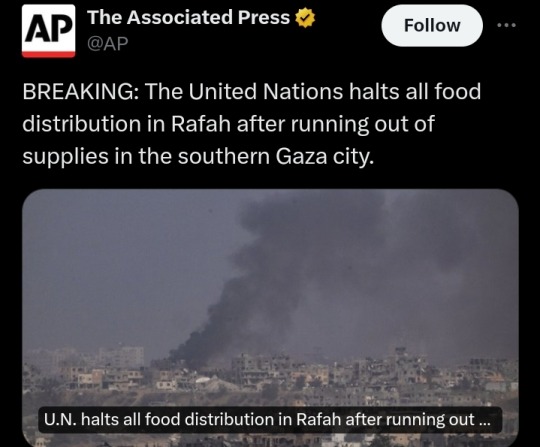
The United Nations said Tuesday it suspended food distribution in the southern Gaza city of Rafah due to lack of supplies and insecurity. It also said no aid trucks entered in the past two days via a floating pier set up by the U.S. for sea deliveries. The U.N. has not specified how many people have stayed in Rafah since the Israeli military began its intensified assault there two weeks ago, but apparently several hundred thousand people remain. The World Food Program said it was also running out of food for central Gaza, where hundreds of thousands of Palestinians fleeing Rafah have sought shelter in a chaotic exodus, setting up new tent camps or crowding into areas already devastated by previous Israeli offensives. Abeer Etefa, a spokesperson for the U.N’s World Food Program, warned that “humanitarian operations in Gaza are near collapse.” If food and other supplies don’t resume entering Gaza “in massive quantities, famine-like conditions will spread,” she said.
The prosecutor at the International Criminal Court cited Israeli Prime Minister Benjamin Netanyahu and Defense Minister Yoav Gallant for alleged “use of starvation as a method of warfare,” a charge they and other Israeli officials angrily deny. The prosecutor accused three Hamas leaders of war crimes over killings of civilians in the group’s Oct. 7 attack. The U.N says some 1.1 million people in Gaza – nearly half the population — face catastrophic levels of hunger and that the territory is on the brink of famine. The crisis in humanitarian supplies has spiraled in the two weeks since Israel launched an incursion into Rafah on May 6, vowing to root out Hamas fighters. Troops seized the Rafah crossing into Egypt, which has been closed since. Since May 10, only about three dozen trucks made it into Gaza via the nearby Kerem Shalom crossing from Israel because fighting makes it difficult for aid workers to reach it, the U.N. says. For months, the U.N. has warned that an Israeli assault on Rafah could wreck the effort to get food, medicine and other supplies to Palestinians across Gaza. Throughout the war, Rafah has been filled with scenes of hungry children holding out pots and plastic containers at makeshift soup kitchens, with many families reduced to eating only one meal a day. The city’s population had swelled to some 1.3 million people, most of whom fled fighting elsewhere. Around 810,000 people have streamed out of Rafah, although Israel says it has not launched the full-fledged invasion of the city it had planned. The United States has said Israel did not present a “credible” plan for evacuating the population or keeping it safe. The main agency for Palestinian refugees, UNRWA, announced the suspension of distribution in Rafah in a post on X, without elaborating beyond citing the lack of supplies. U.N. spokesman Stephane Dujarric said the UNRWA distribution center and the WFP’s warehouses in Rafah were “inaccessible due to ongoing military operations.”
An absolute nightmare
#yemen#jerusalem#tel aviv#current events#palestine#free palestine#gaza#free gaza#news on gaza#palestine news#news update#war news#war on gaza#rafah#all eyes on rafah#famine#gaza genocide#rafah under attack#united nations#genocide
4K notes
·
View notes
Text
“War is what happens when language fails.”― Margaret Atwood This content discusses the social impact of humanitarian crises, the psychology of being vulnerable to war, and the cost of war. It highlights the devastating effects of humanitarian crises on individuals and communities, including displacement, emotional trauma, and long-lasting impacts on vulnerable groups like children. The…

View On WordPress
#defense#offense#war journalism#warfare#earth#environment#environmental science#history#philosophy#war#war industry
0 notes
Link
The game is destabilization of Slavic countries
#Ukraine#EU#European Common Market#agriculture#grain#offensive#economic warfare#destabilization#exploitation#duplicity#division#proxy war#subjugation#geopolitics
0 notes